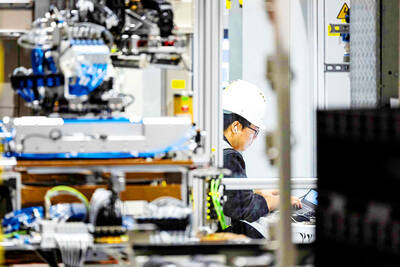Manufacturing activity in Taiwan accelerated last month on improving external and domestic demand, although the impact of Japan’s earthquake disaster started to feed through, an HSBC PLC report released yesterday said.
The HSBC Purchasing Managers Index (PMI), an indicator used to gauge the health of the manufacturing sector, rose for the fifth consecutive month to 58.2 last month, from 55.6 in March, as clients in domestic and overseas markets increased new orders, the report showed.
“Taiwan manufacturers are back on a firmer footing as they sail into the second quarter as evidenced by a strong rise in new business volumes,” said Donna Kwok (郭浩庄), an economist at HSBC Asia.
A PMI score above 50 indicates expansion, while readings below suggest a contraction.
Supply-side disruptions from Japan started to feed through, but an unexpected silver lining has emerged whereby orders are shifted from Japan to Taiwan as a result of recent natural disasters there, Kwok said.
Of the component measures, the sub-index on total new orders improved to 57.8 last month from 55.5 one month earlier, with survey respondents highlighting new business from China and Europe, the report said.
Companies struggled to source products last month as the Japanese earthquake weighed on global supplies of electronics components, the report said.
“Taiwan’s ability to benefit from [order shifts] will be increasingly put to the test this quarter as supply disruptions continue and the West’s recovery rolls over,” Kwok said.
Insufficient raw material supplies, coupled with the growth in new orders, drove the sub-index on work backlogs to 53.2 last month, from 51.5 a month earlier, the report said.
On the price front, input prices remained high at 77.1 and 57.0 last month, but eased off from 82.4 and 60.8 respectively one month earlier, the report said, suggesting some firms passed on greater cost burdens to clients by raising their prices.
About 64 percent of the respondents cited mounting raw material prices, especially of metals — including steel and cooper — as key input cost drivers last month, the report said.
The employment sub-index stood at 55.6 last month, above the expansion threshold for the 22nd month, although slowing from 57.0 in March, the report said.
The figures bode well for Taiwan’s job market recovery, which is necessary for domestic demand expansion, Kwok said.
However, wage inflation was not mentioned by respondents as a factor in the latest increase in input costs, the report said.
The absence of significant wage increase will curb consumer confidence, which may continue to lag job-search confidence, making it hard for gains from the manufacturing sector to translate into strong private consumption growth, Kwok said.
Against that backdrop, the central bank will maintain its current gradual pace of monetary normalization, raising benchmark interest rates 12.5 basis points a quarter, the economist said.

CHIP RACE: Three years of overbroad export controls drove foreign competitors to pursue their own AI chips, and ‘cost US taxpayers billions of dollars,’ Nvidia said China has figured out the US strategy for allowing it to buy Nvidia Corp’s H200s and is rejecting the artificial intelligence (AI) chip in favor of domestically developed semiconductors, White House AI adviser David Sacks said, citing news reports. US President Donald Trump on Monday said that he would allow shipments of Nvidia’s H200 chips to China, part of an administration effort backed by Sacks to challenge Chinese tech champions such as Huawei Technologies Co (華為) by bringing US competition to their home market. On Friday, Sacks signaled that he was uncertain about whether that approach would work. “They’re rejecting our chips,” Sacks

It is challenging to build infrastructure in much of Europe. Constrained budgets and polarized politics tend to undermine long-term projects, forcing officials to react to emergencies rather than plan for the future. Not in Austria. Today, the country is to officially open its Koralmbahn tunnel, the 5.9 billion euro (US$6.9 billion) centerpiece of a groundbreaking new railway that will eventually run from Poland’s Baltic coast to the Adriatic Sea, transforming travel within Austria and positioning the Alpine nation at the forefront of logistics in Europe. “It is Austria’s biggest socio-economic experiment in over a century,” said Eric Kirschner, an economist at Graz-based Joanneum

BUBBLE? Only a handful of companies are seeing rapid revenue growth and higher valuations, and it is not enough to call the AI trend a transformation, an analyst said Artificial intelligence (AI) is entering a more challenging phase next year as companies move beyond experimentation and begin demanding clear financial returns from a technology that has delivered big gains to only a small group of early adopters, PricewaterhouseCoopers (PwC) Taiwan said yesterday. Most organizations have been able to justify AI investments through cost recovery or modest efficiency gains, but few have achieved meaningful revenue growth or long-term competitive advantage, the consultancy said in its 2026 AI Business Predictions report. This growing performance gap is forcing executives to reconsider how AI is deployed across their organizations, it said. “Many companies

France is developing domestic production of electric vehicle (EV) batteries with an eye on industrial independence, but Asian experts are proving key in launching operations. In the Verkor factory outside the northern city of Dunkirk, which was inaugurated on Thursday, foreign specialists, notably from South Korea and Malaysia, are training the local staff. Verkor is the third battery gigafactory to open in northern France in a region that has become known as “Battery Valley.” At the Automotive Energy Supply Corp (AESC) factory near the city of Douai, where production has been under way for several months, Chinese engineers and technicians supervise French recruits. “They